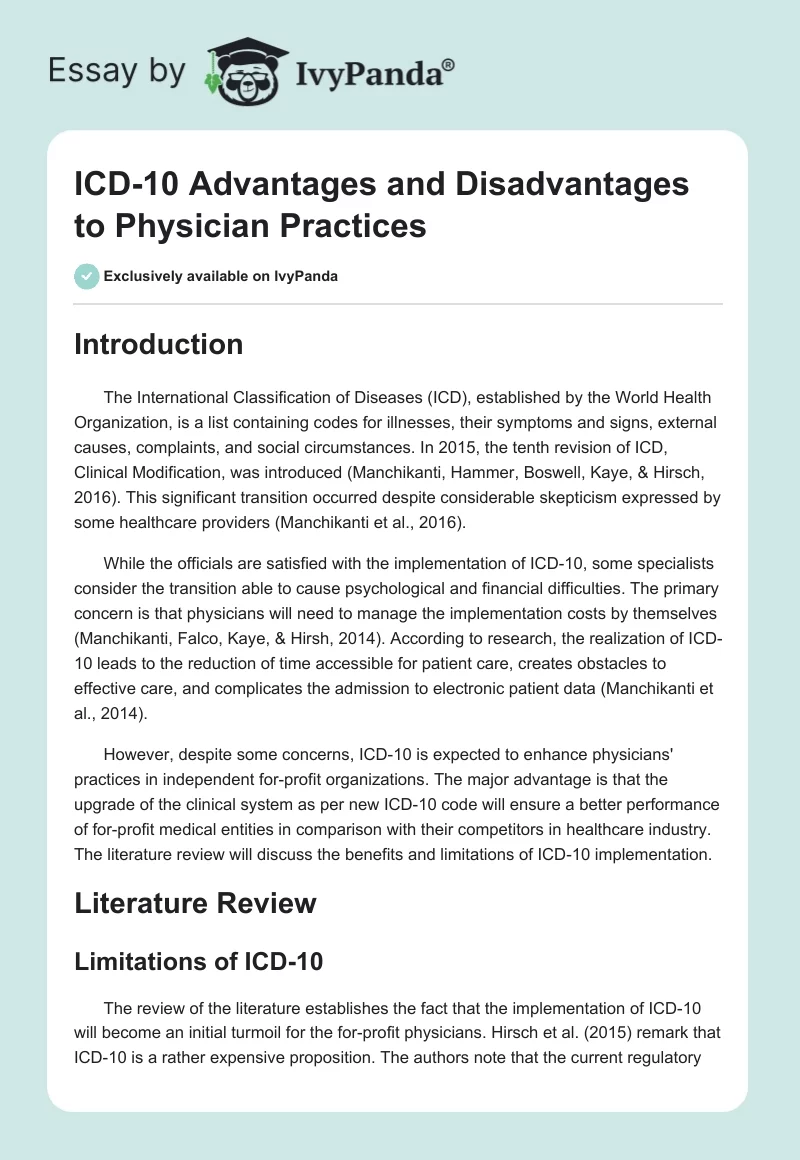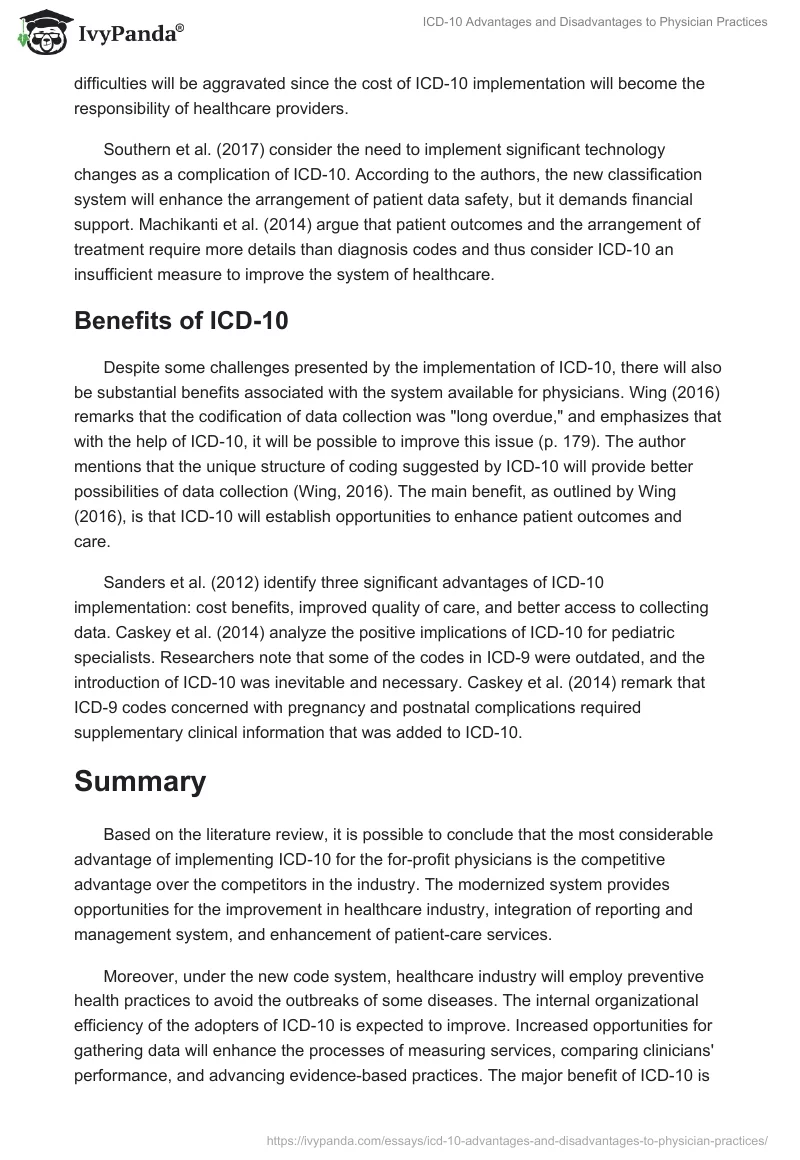Introduction
The International Classification of Diseases (ICD), established by the World Health Organization, is a list containing codes for illnesses, their symptoms and signs, external causes, complaints, and social circumstances. In 2015, the tenth revision of ICD, Clinical Modification, was introduced (Manchikanti, Hammer, Boswell, Kaye, & Hirsch, 2016). This significant transition occurred despite considerable skepticism expressed by some healthcare providers (Manchikanti et al., 2016).
While the officials are satisfied with the implementation of ICD-10, some specialists consider the transition able to cause psychological and financial difficulties. The primary concern is that physicians will need to manage the implementation costs by themselves (Manchikanti, Falco, Kaye, & Hirsh, 2014). According to research, the realization of ICD-10 leads to the reduction of time accessible for patient care, creates obstacles to effective care, and complicates the admission to electronic patient data (Manchikanti et al., 2014).
However, despite some concerns, ICD-10 is expected to enhance physicians’ practices in independent for-profit organizations. The major advantage is that the upgrade of the clinical system as per new ICD-10 code will ensure a better performance of for-profit medical entities in comparison with their competitors in healthcare industry. The literature review will discuss the benefits and limitations of ICD-10 implementation.
Literature Review
Limitations of ICD-10
The review of the literature establishes the fact that the implementation of ICD-10 will become an initial turmoil for the for-profit physicians. Hirsch et al. (2015) remark that ICD-10 is a rather expensive proposition. The authors note that the current regulatory difficulties will be aggravated since the cost of ICD-10 implementation will become the responsibility of healthcare providers.
Southern et al. (2017) consider the need to implement significant technology changes as a complication of ICD-10. According to the authors, the new classification system will enhance the arrangement of patient data safety, but it demands financial support. Machikanti et al. (2014) argue that patient outcomes and the arrangement of treatment require more details than diagnosis codes and thus consider ICD-10 an insufficient measure to improve the system of healthcare.
Benefits of ICD-10
Despite some challenges presented by the implementation of ICD-10, there will also be substantial benefits associated with the system available for physicians. Wing (2016) remarks that the codification of data collection was “long overdue,” and emphasizes that with the help of ICD-10, it will be possible to improve this issue (p. 179). The author mentions that the unique structure of coding suggested by ICD-10 will provide better possibilities of data collection (Wing, 2016). The main benefit, as outlined by Wing (2016), is that ICD-10 will establish opportunities to enhance patient outcomes and care.
Sanders et al. (2012) identify three significant advantages of ICD-10 implementation: cost benefits, improved quality of care, and better access to collecting data. Caskey et al. (2014) analyze the positive implications of ICD-10 for pediatric specialists. Researchers note that some of the codes in ICD-9 were outdated, and the introduction of ICD-10 was inevitable and necessary. Caskey et al. (2014) remark that ICD-9 codes concerned with pregnancy and postnatal complications required supplementary clinical information that was added to ICD-10.
Summary
Based on the literature review, it is possible to conclude that the most considerable advantage of implementing ICD-10 for the for-profit physicians is the competitive advantage over the competitors in the industry. The modernized system provides opportunities for the improvement in healthcare industry, integration of reporting and management system, and enhancement of patient-care services.
Moreover, under the new code system, healthcare industry will employ preventive health practices to avoid the outbreaks of some diseases. The internal organizational efficiency of the adopters of ICD-10 is expected to improve. Increased opportunities for gathering data will enhance the processes of measuring services, comparing clinicians’ performance, and advancing evidence-based practices. The major benefit of ICD-10 is the opportunity to organize better patient care and enhance patient outcomes. However, the new system also presents some considerable challenges. The greatest downside of ICD-10 is the exponential cost increase for the physicians at the implementation stage.
The adoption of a new sophisticated structure means that IT systems will have to be upgraded, new vendors will be sought, and training for the current employees will need to be provided. All these functions demand financial resources, time and management, and the adopters should weigh the costs against benefits before executing the implementation phase. Since the implementation of ICD-10 is inevitable, specialists need to accumulate all resources to minimize the adverse outcomes of the innovations and increase the opportunities for positive change. It is crucial that for-profit physicians remain informed about the development of ICD-10 to keep their practice up-to-date.
References
Caskey, R., Zaman, J., Nam, H., Chae, S.-R., Williams, L., Mathew, G., … Boyd, A. D. (2014). The transition to ICD-10-CM: Challenges for pediatric practice. Pediatrics, 134(1), 31-36.
Hirsch, J. A., Leslie-Mazwi, T. M., Nicola, G. N., Oklu, R., Schoppe, K. A., Silva, E., & Manchikanti, L. (2015). The ICD-10 system: A gift that keeps on taking. Journal of NeuroInterventional Surgery, 7(8), 619-622.
Manchikanti, L., Falco, F. J., Kaye, A. D., & Hirsh, J. A. (2014). The disastrous but preventable consequences of ICD-10. Pain physician, 17(2), 111-118.
Manchikanti, L., Hammer, M. J., Boswell, M. V., Kaye, A. D., & Hirsch, J. A. (2016). A seamless navigation to ICD-10-CM for interventional pain physicians: Is a rude awakening avoidable? Pain physician, 19(1), E1-E14.
Sanders, T. B., Bowens, F. M., Pierce, W., Stasher-Booker, B, Thompson, E. Q., & Jones, W. A. (2012). The road to ICD-10-CM/PCS implementation: Forecasting the transition for providers, payers, and other healthcare organizations. Perspectives in Health Information Management, 9, 1f.
Southern, D. A., Burnand, B., Droesler, S. E., Flemons, W., Forster, A. J., Gurevich, Y.,… Ghali, W. A. (2017). Deriving ICD-10 codes for patient safety indicators for large-scale surveillance using administrative hospital data. Medical care, 55(3), 252-260.
Wing, T. L. (2016). ICD-10 medical coding: The role of perioperative services in addressing implementation challenges. AORN journal, 103(2), 177-188.


